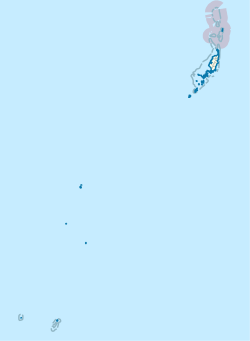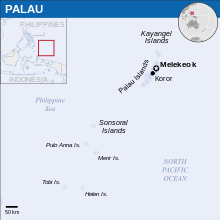Kayangel
Kayangel | |
|---|---|
 | |
 Location of Kayangel in Palau | |
| Country | |
| Capital | Orukei |
| Government | |
| • Governor | Richard Ngiraked |
| Area | |
| • Total | 1.4 km2 (0.5 sq mi) |
| Population (2015 Census) | |
| • Total | 54 |
| • Density | 39/km2 (100/sq mi) |
| • Official languages | Palauan English |
| ISO 3166 code | PW-100 |

Kayangel[1][2] (Ngcheangel) is the northernmost state of Palau[3][4] 86 km (53 mi) north of Koror. The land area is about 1.4 km2 (0.54 sq mi). The population is 54 (2015 census). There is one hamlet in the state - Orukei, which is also its capital. In 2020, Richard Ngiraked was elected governor of the state.[5]
History
[edit]The state was colonized by Spain from the end of the 16th century until 1899 when the territory was sold to the German Empire. This situation continues until the First World War when Japan took control of the atolls. The United States ruled the area from World War II until the independence of Palau.
The Palau Parliament passed a joint resolution in January 2005 supporting a 2002 agreement between the Kayangel State and Palau Pacific Energy Inc. (PPE) in 2002, granting the oil company exclusive rights to explore, drill and produce oil in the surrounding marine area for a specified period of time. Initially, the Palau government had opposed this on environmental grounds, but then bowed to a 2003 petition by Kayangel State residents in favor of exploration.
Typhoon Haiyan
[edit]In 2013 Typhoon Haiyan left its wake of destruction on the island, causing Kayangel to be flooded in its entirety, and all homes were destroyed. No fatalities were reported, but 69 people were affected by this cyclone.
Demography
[edit]The population of the state was 54 in the 2015 census and median age was 37.5 years.[6] The official languages of the state are Palauan and English.[7] Rdechor is the title of the traditional high chief from the state.[8]
Political system
[edit]The state of Kayangel, with population of less than 60, has an elected chief executive, governor. The state also has a legislature elected every four years.[9] The state population elects one of the member in the House of Delegates of Palau.
Geography
[edit]The state consists of three atolls in different states of development:
| Atoll | Land Area (km2) |
Total Area (km2) |
Coordinates |
|---|---|---|---|
| Kayangel | 1.39 | 21.6 | 08°04′N 134°42′E / 8.067°N 134.700°E |
| Ngaruangel | 0.02 | 20.1 | 08°10′N 134°38′E / 8.167°N 134.633°E |
| Velasco Reef | - | 330 | 08°20′29″N 134°36′45″E / 8.34139°N 134.61250°E |
| State of Kayangel | 1.40 | 372 |
Kayangel Atoll
[edit]

Kayangel Atoll (Ngcheangel), the only inhabited atoll of Kayangel State, with most (99 percent) of the land area of Kayangel State, is located at 08°04′N 134°42′E / 8.067°N 134.700°E, about 35 km (22 mi) north of Babelthuap island, the main island of Palau, but only 3 km (1.9 mi) north of Babelthuap's barrier reef. The atoll is about 7.2 km (4.5 mi) north-south, and 3.7 km (2.3 mi) wide, with a total area of 20 km2 (7.7 sq mi), including the lagoon. The lagoon has an average depth of 6 m (20 ft) and a maximum depth of 9.6 m (31 ft), and about 25 large pinnacles can be detected from aerial photographs. The bottom of the lagoon is largely sand. On the western side of the atoll, there is a small passage for boats into the lagoon, with a depth of only 2 to 4 metres (7 to 13 ft), called Ulach. Coral diversity and abundance are low in the lagoon. Large fish, dolphins and foraging sea turtles are common near the pass.
There are four densely wooded islets on the eastern and southern rim of the oval-shaped atoll, from north to south, are Kayangel, Ngeriungs, Ngerebelas and Orak.
Kayangel Islet
[edit]Kayangel Islet (also called Ngcheangel or Ngajangel), is the largest and only inhabited islet of Kayangel Atoll and Kayangel State. It is 2,570 m (8,430 ft) long north–south, with a width between 270 m (890 ft) in the south and 700 m (2,300 ft) in the north. The land area is about 98 ha (240 acres). There are five villages primarily oriented to the western shore (lagoon side). They stretch over 1.5 km (0.93 mi) from north to south and are not clearly separated from each other. The villages are very small by any standard, given the aggregate population of only 138. Together, they make up the state capital, Kayangel (Ngcheangel). From north to south:
- Orukei
- Dilong
- Doko (with 130 m (430 ft) long pier to the west into the lagoon)
- Olkang
- Dimes
The only power on the island comes from solar panels or personal generators. There is one small school that goes from K-9th grades and a small library. The only shopping to be done on the island is from a small general store, otherwise it is what the islanders catch in the ocean or grow in the ground. There are several ways to get to the island. One is the island's speedboat that takes about two hours, but it is generally in for repairs. The more reliable modes are from either a local fisherman or a dive company that makes regular trips up to the island to dive off the reefs surrounding the island.[10]
Ngeriungs Islet
[edit]Ngeriungs Islet, about 820 m (2,690 ft) south of Kayangel Islet, is 1,350 m (4,430 ft) long north–south, and has a width between 130 m (430 ft) in the south and 380 m (1,250 ft) in the north, which amounts to a land area of 27 ha (67 acres). There is a small campsite. The islet has been designated an Important Bird Area (IBA) by BirdLife International because it supports a large population of Micronesian megapodes.[11]
Ngerebelas Islet
[edit]Ngerebelas Islet, close to the southern tip of Kayangel atoll, about 1,200 m (3,900 ft) southwest of the southwestern tip of Ngeriungs Islet, has a size of 400 m (1,300 ft) east-west by 370 m (1,210 ft) north-south, with a land area of 12 ha (30 acres).
Orak Islet
[edit]Orak Islet, at the southern tip of Kayangel atoll, about 290 m (950 ft) southwest of the southwestern end of Ngerebelas Islet, is 210 m (690 ft) long southwest–northeast, and 90 m (300 ft) wide. With an area of 1.5 ha (3.7 acres), it is the smallest of the four islets of Kayangel Atoll.
Ngaruangel Reef
[edit]Ngaruangel (Ngaruangl) Reef, located at 08°10′N 134°38′E / 8.167°N 134.633°E, is an incipient atoll, 8.7 km (5.4 mi) northwest of Kayangel atoll, and separated from it by Ngaruangl Passage, a very deep (629 to 786 metres (2,064 to 2,579 ft) at 2 km (1.2 mi) from each atoll) and 8 km (5.0 mi) wide passage. The atoll is 5.4 km (3.4 mi) long north–south, and from 1.8 km (1.1 mi) wide in the north to 3.7 km (2.3 mi) in the south, and about 3 km (1.9 mi) on the average. The total area including the lagoon is 15 km2 (5.8 sq mi). The lagoon is shallow, with an average depth of 6 m (20 ft), has about 115 pinnacle and patch reefs, and a boat passage through the northeastern part of the barrier reef. The lagoon floor is covered with thick sand deposits and thickets of staghorn Acropora. The reef is protected by Ngaruangel Reserve.
Ngaruangel Island
[edit]There is one small, barren and uninhabited islet, Ngaruangel Island, in the center of the eastern rim of the atoll, at its easternmost point. Ngaruangel Island is 200 m (660 ft) long north–south, and from 65 m (213 ft) wide in the south to 105 m (344 ft) in the north. There is a sand spit attached to the island, pointing southwest into the lagoon, 75 m (246 ft) long and 20 m (66 ft) wide. The total area of the island is 1.5 ha (3.7 acres).
The islet consists almost entirely of pieces of rough coral rock thrown up by surf. Most of the pieces are rough or sharp and are largely of the Acropora reticulata type, or of similar form. Sand and sandy gravel are limited to the lagoon side and the southern tip. The altitude is a little less than one meter above high tide. There is no vegetation on the islet. Animal life is represented by numerous marine crane flies. Terns are abundant.
Velasco Reef
[edit]Velasco Reef, located at 08°20′29″N 134°36′45″E / 8.34139°N 134.61250°E is a sunken atoll north of Ngaruangl Reef, rising steeply from the surrounding seafloor, 2,000 metres (6,600 ft) deep. It is not clearly separated from Ngaruangl Reef and appears as its large but submerged northern extension on satellite images. It extends more than 30 km (19 mi) to the north, and is up to 14 km (8.7 mi) wide, giving it an oval shape, covering an area of about 330 km2 (130 sq mi). Much of the reef is uncharted. The central depression (lagoon) is 31 to 55 m (102 to 180 ft) deep, while depths along the rim (outer edges) range from 11.9 to 22 m (39 to 72 ft) (generally 15 to 20 m (49 to 66 ft)), on which there are overfalls when the tidal currents are strong. Heavy wave exposure limits coral diversity and cover on Velasco Reef.
Education
[edit]The Ministry of Education operates public schools.
JFK Kayangel Elementary School was built in 1965; initially students took classes in a bai. It relieved the schools in Babeldaob as Kayangel students previously attended those schools.[12] Ngaraard Elementary School in Ngaraard formerly served Kayangel.[13]
Palau High School in Koror is the country's only public high school, so children from this community go there.[14]
References
[edit]- ^ Olsudong, Rita (2006). Final Inventory of Historic Properties in Kayangel States, Republic of Palau. Bureau of Arts and Culture, Palau Historic Preservation Office, Ministry of Community and Cultural Affairs.
- ^ Trust Territory of the Pacific Islands. Bureau of International Organization Affairs, Office of United Nations Political Affairs.
- ^ Holyoak, Lorne (2005). Ethnographic and Oral History Survey of Kayangel State, Republic of Palau. Palau Bureau of Arts and Culture and Historic Preservation Office, Ministry of Community and Regional Affairs.
- ^ Federal Information Processing Standards Publication. U.S. Government Printing Office. 1994.
- ^ "KAYANGEL GOVERNOR RETURNS $100K FOR SEABED LEASE – Tia Belau Newspaper". 2021-10-04. Retrieved 2024-04-29.
- ^ "2015 Census of Population, Housing and Agriculture for the Republic of Palau" (PDF). Palau Government. Office of Planning and Statistics.
- ^ Leonard, Thomas M. (2006). Encyclopedia of the Developing World. Taylor & Francis. ISBN 9780415976640.
- ^ "Council of Chiefs – PalauGov.pw".
- ^ "State/National Election Schedule". Palau Election Commission. 5 November 2020.
- ^ Snyder, David.; Adams, William Hampton; Butler, Brian M. (1997). Archaeology and historic preservation in Palau. Anthropology research series / Division of Cultural Affairs, Republic of Palau 2. San Francisco: U.S. National Park Service.
- ^ "Ngeriungs, Palau". BirdLife Data Zone. BirdLife International. 2021. Retrieved 6 March 2021.
- ^ "JFK Kayangel Elementary School Archived 2018-08-09 at the Wayback Machine." Ministry of Education (Palau). Retrieved on February 22, 2018.
- ^ "Ngaraard Elementary School Archived 2018-03-03 at the Wayback Machine." Ministry of Education (Palau). Retrieved on February 22, 2018.
- ^ "About Archived 2018-03-03 at the Wayback Machine." Palau High School. Retrieved on February 22, 2018.

